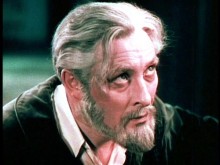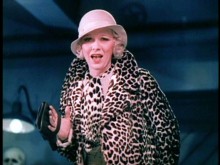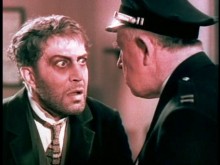Not a sequel, but very much a companion piece to Michael Curtiz’ Doctor X (1932), the once-lost Mystery of the Wax Museum (1933) is another two-strip Technicolor exercise in German Expressionist horror with two of the same stars—Lionel Atwill and Fay Wray—and a similar reporter hero, only this time it’s a heroine (Glenda Farrell). This is the original version of House of Wax (1953), the film that turned Vincent Price into a horror star, and it’s every inch the superior film. That has a lot to do with the older film’s pre-code ability to go places and do things that would never get past a 1953 censor (in some ways, it’s surprising even today), but it also just plain has a better script, better (less campy) acting and better direction. The oddity is that the 1933 film ends up feeling fresher and more modern than the remake of 20 years later. The stories are much the same—a wax museum with statues that aren’t what they seem—but the approaches couldn’t be more different, starting with the fact that the earlier film is actually structured as a mystery. The result is a true classic of horror.

The two versions are a study in contrasts. (There’s really no point in dragging the 2005 House of Wax into this, since whatever it is, it has little or nothing to do with either film. I don’t care how much you like seeing Paris Hilton get a pole through her head.) Mystery of the Wax Museum is Expressionist horror. House of Wax is purely gothic horror, which may be an outgrowth of the first film’s prologue. The original opens in London in 1921, but the feeling is of an earlier era in both clothes and the fact that the only conveyance we see is a horse-drawn carriage.The openings are very similar in depicting the wax museum being set on fire for insurance money by the sculptor’s (Atwill/Price) unscrupulous business partner (Edwin Maxwell/Roy Roberts), who leaves the sculptor to die in the blaze. However, the original then jumps New York in 1933. The remake stays in period, junks the mystery element, the reporter heroine—and succumbs to the temptation of making fun of how quaint the era is. As comedy, it’s a really poor substitute for Glenda Farrell’s wisecracks.And goodness knows, turning Arthur Edmund Carewe’s flamboyant junkie from the original into an alcoholic is an equally weak exchange.

Both movies can be said to use a gimmick. The original being in color was virtually a gimmick in 1933, though chances are that it had more to do with using up commitments to the Technicolor company than anything else. (Doctor X was pretty clearly that, since it was only released in color in major cities.) But Michael Curtiz and cinematographer Ray Rennahan made artistically defensible use of the process.The remake, on the other hand, was in 3D (though directed by one-eyed filmmaker Andre De Toth), which is harder to defend on artistic grounds—unless you consider a guy hitting a flyback paddle at the audience artistic.

What’s interesting about Wax Museum with audiences who are famiiliar with neither film is the mystery angle. Knowing the story far too well from House of Wax when I first saw the film after its rediscovery (after years of searching archives worldwide, it turned out to be in Jack Warner’s personal library) the mystery was no mystery at all to me—and the film’s “big shock” was fully expected. Then I got ahold of a bootleg 16mm print and started showing it around, and damned if people who didn’t know anything about the film actually were suprised—at least occasionally. It’ll be interesting to see how that plays out when the movie screens.




Given the audible gasps from quite a few in the audience tonight at the movie’s “big shock” moment, I’d say the mystery element still holds up after 78 years. Kind of surprising actually. I have to ask if any of the folks who have written over and over since this film was found in the late 1960s that Glenda Farrell’s comedy wears thin have ever watched the movie with an audience?
I didn’t get a chance to see this at the Carolina, but did recently watch it at home. I agree completely with your take on it vis-a-vis the remake. For my money, Glenda Farrell was the standout performer in the film; she made the others seem almost wooden in comparison.
And the ending does still pack a punch.
I didn’t get a chance to see this at the Carolina
We haven’t seen you in some considerable time. Nor the entirely vanished Dread P. Roberts, come to that.
And the ending does still pack a punch.
Considering that 16mm bootleg I mentioned was the second feature film I owned, I’m willing to bet that this is something I’ve seen into the triple digit range. (My friends and I tended to run the same movies over and over until a new title came along.) As a result, I am so used to the film that I even anticipate things like the emulsion scratch (white line) over the electric “Happy New Year” sign. It always seems so cool to me to see a new audience react to that.
“We haven’t seen you in some considerable time.”
Well, I am still somewhat limited physically as a result of my surgery, so I haven’t gotten out too much, but fully intend to see some more of those Thursday night showings in the very near future.
Well, I am still somewhat limited physically as a result of my surgery, so I haven’t gotten out too much, but fully intend to see some more of those Thursday night showings in the very near future.
We’ll certainly be watching for you.